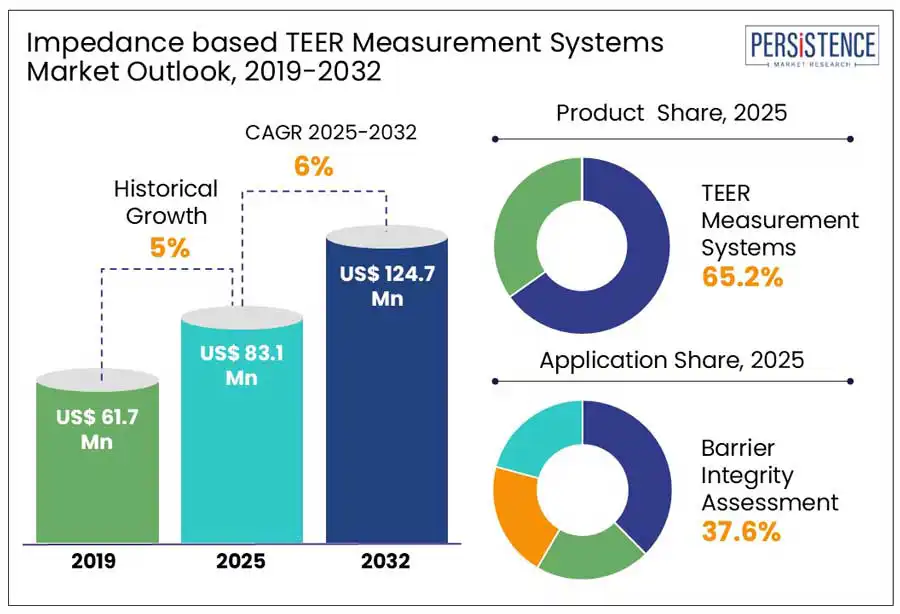Comprehensive Snapshot of Impedance-based TEER Measurement Systems Market Report Including Regional and Country Analysis
Industry: Healthcare
Published Date: April-2025
Format: PPT*, PDF, EXCEL
Delivery Timelines: Contact Sales
Number of Pages: 180
Report ID: PMRREP35190
The global impedance-based teer measurement systems market size is anticipated to reach a value of US$ 83.1 Mn in 2025 to witness a CAGR of 6.0% by 2032. According to Persistence Market Research, the market is poised to attain a value of US$ 124.7 Mn in 2032. Advancements in cell-based assays, drug discovery, and organ-on-chip models have become widely popular.
Axion BioSystems’ Maestro ZHT offers 96-well plates for label-free, continuous monitoring, enhancing data accuracy over traditional electrodes. Similarly, nanoAnalytics’ cellZscope offers computer-controlled, multi-well impedance analysis, eliminating user variability and ensuring reproducible, long-term TEER (Trans Epithelial/Endothelial Electrical Resistance) measurements critical for studying drug permeability and barrier function changes.
With a push toward in vitro models to reduce animal testing, the adoption of high-throughput TEER platforms is accelerating. These advanced systems streamline workflows, capturing real-time kinetic data for predictive toxicology and disease modeling. As regulatory bodies emphasize reliable cell-based assays, impedance-based TEER technologies will remain vital in biomedical research and personalized medicine.

Key Industry Highlights:
|
Global Market Attribute |
Key Insights |
|
Impedance-based TEER Measurement Systems Market Size (2025E) |
US$ 83.1 Mn |
|
Market Value Forecast (2032F) |
US$ 124.7 Mn |
|
Projected Growth (CAGR 2025 to 2032) |
6.0% |
|
Historical Market Growth (CAGR 2019 to 2024) |
5.0% |
The increasing use of complex in vitro models (CIVMs), such as organ-on-a-chip systems, micro physiological systems (MPS), and organoids is fueling the demand for precise cell barrier integrity assessments. These models provide more physiologically relevant conditions than traditional 2D cultures and animal testing, leading to improved drug screening and toxicity testing.
For example, the Critical Path Institute (C-Path) has developed a framework for FDA qualification of complex in vitro models (CIVMs), supporting their regulatory acceptance. This initiative is crucial as pharmaceutical and biotech companies increasingly rely on organ-on-a-chip and tissue engineering models for drug screening and toxicity testing.
Companies such as Emulate and CN Bio have developed micro physiological systems that mimic human organ functions with precise TEER measurement systems to assess cell barrier integrity. As these models gain regulatory backing and industry adoption, impedance-based TEER measurement systems play a vital role in ensuring accurate, reproducible data for drug safety and efficacy evaluations.
Integrating impedance-based TEER measurement systems with established biological and pharmacological assays presents challenges, as differences in experimental conditions, electrode configurations, and culture environments can affect data consistency. For example, while TEER measures barrier integrity, researchers often need to correlate it with permeability assays such as FITC-dextran transport. Standardizing protocols across multiple assays is essential but requires optimization and validation, increasing complexity for labs adopting TEER technology. Additionally, pharmaceutical companies integrating TEER with high-throughput screening (HTS) platforms face compatibility issues, requiring custom adaptations to maintain workflow efficiency.
The advancement of miniaturized, handheld TEER measurement systems presents a significant opportunity for clinical diagnostics and real-time monitoring of barrier integrity. Portable TEER devices could enable on-site assessments of epithelial and endothelial health, benefiting applications in wound healing, infection monitoring, and personalized medicine. For example, researchers are developing lab-on-a-chip TEER platforms that integrate microfluidics and impedance sensing, allowing rapid, non-invasive evaluations at the point of care. Such innovations could enhance early disease detection and treatment monitoring, making TEER technology more accessible beyond research labs and into clinical and diagnostic settings.
The TEER measurement systems are expected to hold around 65.2% share in 2025. The growth is primarily driven by the increasing adoption of in vitro models, such as cell monolayers, tissue barriers, and organ-on-a-chip systems, across pharmaceuticals, biotechnology, and academic research. These models enhance drug screening, disease modeling, and toxicity testing further fueling demand for TEER measurement systems as a reliable tool for assessing cell barrier integrity and permeability.
Barrier integrity assessment is expected to account for the high share approximately 37.6%, in 2025. This is driven by its widespread use in drug discovery, disease modeling, and organ-on-a-chip research, where epithelial and endothelial barrier function are critically assessed. The growing adoption of in vitro models for studying conditions such as blood-brain barrier permeability, intestinal absorption, and lung epithelium function further fuels demand for TEER measurement systems in this application.

North America is expected to dominate 39.4% of the global impedance-based TEER measurement systems market by 2025, driven by strong pharmaceutical R&D investments and government support. According to the OECD, in 2021, the U.S. alone allocated $45 billion for health-related R&D, accounting for nearly two-thirds of government funding across 35 OECD countries. This substantial investment fuels advancements in drug discovery, toxicology testing, and organ-on-chip research, increasing the adoption of TEER measurement systems. For example, the NIH and FDA’s support for in vitro models has accelerated the development of automated, high-throughput TEER platforms, strengthening North America’s market leadership.
By 2025, Asia's share is expected to reach 17.6% driven by cutting-edge research and technological innovation. For example, researchers at the Institute of Microelectronics, Chinese Academy of Sciences in Beijing have developed a real-time TEER system with an organ chip and plate electrode, improving measurement accuracy by accounting for non-cell-covered regions. Similarly, Tohoku University in Japan has introduced scanning probe microscopy (SPM) for micro physiological systems (MPS), enabling high-resolution visualization of cell functions. These advancements are fueling the adoption of TEER systems in drug development and biomedical research across Asia.
The global impedance-based TEER measurement systems market is highly competitive, with key players such as nanoAnalytics GmbH, World Precision Instruments, Applied BioPhysics, Inc., Merck KGaA, Sciospec Scientific Instruments GmbH, and Axion BioSystems, Inc. These companies are driving innovation through real-time monitoring, microfluidic integration, and high-throughput screening, enhancing applications in drug development, toxicology studies, and organ-on-chip research.
|
Report Attribute |
Details |
|
Historical Data/Actuals |
2019 - 2024 |
|
Forecast Period |
2025 - 2032 |
|
Market Analysis Units |
Value: US$ Mn Volume: As Applicable |
|
Geographical Coverage |
|
|
Segmental Coverage |
|
|
Competitive Analysis |
|
|
Report Highlights |
|
|
Customization and Pricing |
Available upon request |
By Product
By Application
By End-User
By Region
To know more about delivery timeline for this report Contact Sales

The global impedance-based TEER measurement systems market is estimated to increase from US$ 83.1 Mn in 2025 to US$ 124.7 Mn in 2032.
The global impedance-based TEER measurement systems market is driven by advancements in drug testing, organ-on-chip technology, and biomedical research investments.
The market is projected to record a CAGR of 6.0% during the forecast period from 2025 to 2032.
Major players include nanoAnalytics GmbH, World Precision Instruments, Applied BioPhysics, Inc, Merck KGaA, Sciospec Scientific Instruments GmbH, Axion BioSystems, Inc, among others.
Opportunities in the impedance-based TEER measurement market include organ-on-chip integration, AI-driven data analysis, and rising demand for high-throughput screening in biomedical research.